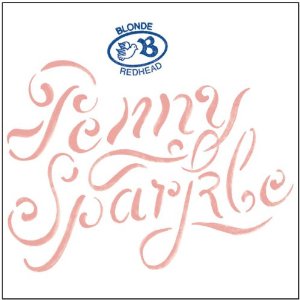Once upon a time Blonde Redhead were beautiful. It took a decade of suspiciously designer no wave, but with 2004’s Misery Is a Butterfly they finally came into their own. A blood-chilling collection of songs, the mothball smell of antique desolation filled a very eerie setting of falling sand-timers and decaying flowers, ornate with dramatic strings and a porcelain sorrow. It was without doubt one of the releases of the year from a time when New York had more than five different sounds. Then, as befitting of an album of such transient delicacy, no sooner had they found their voice than it was gone.
They followed it up with the velveteen 23 – their indie-hit. While on Misery… they’d proved their artistic autonomy, their 2007 release felt like regression. The plucked carefulness of their zenith was flattened for carpeting. It was facile and comparatively banal, and like in their no wave days relied too heavily on borrowed magic, this time that of French perennials the M83. Penny Sparkle is a step backwards again towards contrivance and duplication. Once described by the NME as "Some of the most wildly original music-makers in America", the difference this time is that they’re targeting the damn well sacrosanct tract of Scandi avant-pop, and have bastardised it in the process, stepping on one pinky toe too many.
Up-and-coming Stockholm production duo Van Rivers & The Subliminal Kid have been left to carry a tiring band on Penny…. The result is something equidistant between Bjork’s enchanted post-punk and the synth unbehagen of The Knife’s, yet neither as sublime, cutting edge or exotic as either. Courtesy of the Fever Ray producers, they have the mise-en-scene; there’s the increased emphasis on percussion now piloting the songs, the rustling, popping, crawling electronics, the groaning depth of the drum sounds. Yet still it’s BRH’s most fallow, numberless release to date. Why?
Like the best in sadistic Film Noir, since the 80s the best Scandinavian music accounts for both side of the modern coin – that Weberian nightmare of hyper-rationalism, and its negative: the absence of reason – ambiguity, ambivalence, the futility of absolute truth, godlessness and the relativity of morality, all that big, serious stuff. Music which, in a very real sense, transubtantiates the schema of 20th century social theorists into aural form, and some mint pop if we’re lucky.
For example, Nihilism – the sacred text of punk – once interpreted by Jean Baudrilliard like so: "The apocalypse is finished, all that remains is the fascination for desertlike and indifferent forms, for the very operation of the system that annihilates us." Consider the systematized tundras from Spiderland then Sigor Ros, Bjork’s voice caroming across the sub-arctic over Nelle Hooper’s gasping pistons, the fingernail of Norway as it curls towards the endless steppes of Northern Russia. And another from ole’ JB: "We are fascinated by all forms of disappearance, of our disappearance. Melancholic and fascinated" – could you dream up a better blurb for Fever Ray’s new’un?
And then you have Penny Sparkle, which by comparison materialises such informant texts as iTunes’ ‘Indie Big Ones’ and The Dilettante’s Guide To Being Handsome And Sad All At Once. The north of Kiel sound is utilitarian but fictive like constructivist architecture. It’s severe but perception-altering like a Cubist art. It’s The Scream meats Belgium Teckno meets The Residents. In contrast, transposing their shop-worn song style onto alien territory, the trio have instead turned in something a bit buttery, too vanilla, and relaxing where it should have been disquieting. I think it was Snuffkin Moomin who once said "One can never be entirely free, if one admires someone else too much." Weird bastard.
Typically of the New Yorkers the handling of texture is impeccable, some of the deftest synth-work you’ll hear all year. But melody determines ‘sound’ as much as denatured atmospherics and harsh rhythms. Herein lies their folly. When Beth Gibbons goes all microtonal with Portishead like say on ‘Threads’, and her chromatic notes seem to feed from her soul rather than free it, Gibbon’s tune is just as vital as Geoff Burrow’s inky production. In carrying Mikino’s dolorously earthy melodies over from previous albums they’ve compromised the tone of despair, the tension, the essence of modernity. Her despondent mewing doses the music with too much sumptuous relief; it’s too human in these circumstances. There’s just too much pathos to the way she annunciates her sadness on the title track, the vocals sitting on top of the dubby touches like cream on diesel. It’s their undoing on Penny Sparkle. Tastefulness in music is the anti-despair.
Besides that Penny Sparkle isn’t exactly an enthralling listening experience. The likes of ‘Oslo’, ‘Love or Prison’ and ‘Will There Be Stars’ are cripplingly enervated, coming and going like the sad little food cartons that travel brightly lit Go Sushi!’s. While smooth, soothingly cinematic and endowed with a certain enigmatic poise, the songs aim for detachment and find lethargic restraint, or confuse grace and mystery with an aggravating coyness.
Towards the end they’ve appeared to have tired of the pretence. With ‘Everything is Done’, ‘Black Guitar’ and the return of guitars to the fore, come echoes of Misery and its nouveau vague allure. Suddenly on ‘Spain’ we’re returned to the set of Misery‘s maudlin spy-caper. Decadent zoom shots retreat to a binocular-draped spooks, nefarious men in woollen suits conspire on windy Mediterranean esplanades and denatured stock – a ‘tragic glamour’ as the All Music Guide described Misery…. ‘Spain’ might also be the first case of a band overtly influenced by the XX.
It’s easy to enjoy the songs on Penny… but to this reviewer the mimicry and awkward recreation on show is like those people talking in the cinema when all want to do is soak up the joys of widescreen delight. And would you fight a grown man if he’s talking through vital plot points, even if he’s wearing rings? Now that’s modern art.


